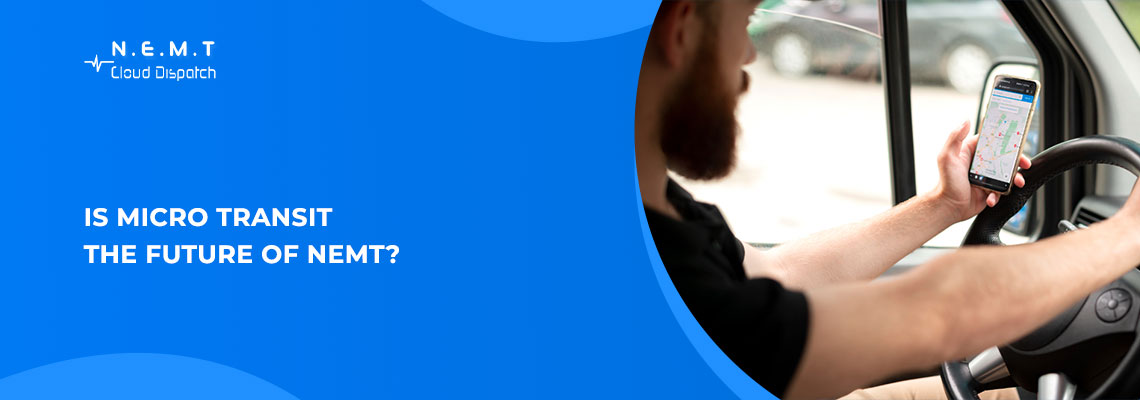Non-Emergency Medical Transportation (NEMT) is a vital service for elderly individuals who need reliable transportation to and from healthcare facilities. Traditionally, NEMT has relied on scheduled rides provided by specialized vehicles, often through Medicaid and private insurance programs.
However, with advancements in technology and changing urban mobility trends, micro transit is emerging as a promising solution to enhance the efficiency and accessibility of NEMT services. But is micro transit the future of NEMT? At NEMT Cloud Dispatch, let’s explore this question in detail.
Understanding Micro Transit
Micro transit is a flexible, on-demand transportation service that operates within a specific geographic area. It typically involves smaller vehicles, such as vans or shuttles that can be booked through mobile apps or call centers. Unlike traditional NEMT services that require pre-scheduling, micro transit allows for dynamic routing, meaning passengers can be picked up and dropped off more efficiently based on real-time demand.
Benefits of Micro Transit for NEMT Providers
The integration of micro transit into NEMT can provide several key benefits:
Enhanced Accessibility and Convenience
Micro transit allows for real-time ride requests, reducing the need for patients to schedule trips days or weeks in advance. This flexibility is particularly useful for last-minute medical appointments or situations where transportation needs change unexpectedly.
Cost Efficiency Improvements
Traditional NEMT services often involve high operational costs due to inefficient scheduling, vehicle maintenance, and administrative overhead. Micro transit, powered by intelligent routing algorithms, can reduce fuel consumption, vehicle idle time, and unnecessary detours, ultimately lowering costs for both service providers and patients. Compare The Cost of Manual NEMT Operations vs. Automated Software Solutions to see potential savings.
Reduced Patient Wait Times
One of the biggest challenges in NEMT is long wait times. Many patients experience delays due to rigid schedules and vehicle availability issues. Micro transit can address this problem by dynamically adjusting routes based on real-time demand, ensuring that patients receive timely pickups and drop-offs.
Improved Patient Comfort
Patients using NEMT services often face:
Multiple transfers
Long ride durations
Crowded vehicles
Micro transit offers a more personalized experience with smaller vehicle capacity and optimized routes, leading to a smoother and more comfortable journey.
Optimized Resource Utilization
Micro transit makes it possible to optimize vehicle usage by matching supply with demand more effectively. By leveraging AI-powered dispatching systems, NEMT providers can ensure that vehicles are utilized efficiently, reducing the number of empty rides and maximizing service coverage.
Challenges in Adopting Micro Transit for NEMT
Despite its advantages, integrating micro transit into NEMT is not without challenges:
Regulatory Compliance Hurdles
NEMT providers must comply with strict federal and state regulations regarding patient safety, vehicle requirements, and insurance coverage. Ensuring that micro transit services meet these requirements can be a complex process.
Technology Adoption Barriers
Many NEMT users, particularly elderly and disabled patients, may struggle with using mobile apps to book rides. Providers will need to offer alternative booking methods, such as phone-based reservations, to ensure accessibility for all users. Learn Why Do NEMT Companies Need a Passenger App addresses accessibility needs.
Infrastructure Investment Needs
Shifting to a micro transit model requires investment in technology, software, and fleet optimization tools that are important to utilize nowadays. Securing the necessary funding and infrastructure to support this transition can be a significant hurdle for many NEMT providers.
Workforce Training Requirements
Drivers and dispatchers accustomed to traditional NEMT operations may require training to adapt to new technologies and dynamic scheduling methods. Managing this transition effectively is crucial for the success of micro transit integration.
The Future of Micro Transit in NEMT
Despite these challenges, micro transit holds immense potential for transforming NEMT. As urban mobility solutions continue to evolve, we are likely to see increased collaboration between NEMT providers, technology firms, and healthcare institutions to make micro transit a viable alternative to traditional NEMT models.
Conclusion
Micro transit is not just a trend, it’s a potential game-changer for NEMT. By improving accessibility, reducing costs, and enhancing the patient experience, micro transit can address many of the inefficiencies in the current NEMT system. However, its widespread adoption will require overcoming regulatory, technological, and financial barriers. With the right approach, micro transit could very well be the future of NEMT, offering a more responsive, cost-effective, and patient-friendly transportation solution for those who need it most.
Ready to see how micro transit can revolutionize your NEMT operations? Book a Demo today to discover tailored solutions for your business


